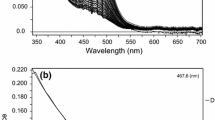Abstract
The catalytic effect of ruthenium(III) on the oxidation of N, N-dimethyl- N ′-(4H-1,2,4-triazol- 3-yl) formamidine (ATF) by hexacyanoferrate(III) (HCF) was studied spectrophotometrically in aqueous alkaline medium. Both uncatalyzed and catalyzed reactions showed first order kinetics with respect to [HCF], whereas the reaction orders with respect to [ATF] and [OH −] were apparently less than unity over the concentration range studied. A first order dependence with respect to [RuIII] was obtained. Increasing ionic strength increased the rate of uncatalyzed reaction and decreased the rate of the catalyzed one Plausible mechanistic schemes of oxidation reactions have been proposed. In both cases, the final oxidation products are identified as aminotriazole, dimethyl amine and carbon dioxide. The rate laws associated with the reaction mechanisms are derived. The reaction constants involved in the different steps of the mechanisms were calculated. The activation and thermodynamic parameters have been computed and discussed.

The catalytic effect of ruthenium(III) on the oxidation of N,N-dimethyl-N’-(4H-1,2,4-triazol-3-yl) formamidine by alkaline hexacyanoferrate(III) has been studied. The final oxidation products are identified as aminotriazole, dimethyl amine and carbon dioxide.










Similar content being viewed by others
References
Devra V and Yadav M B 2012 Russ. J. Chem. 5 67
Shukla R and Upadhyay S K 2008 Indian J. Chem. 47A 551
Jose T P, Nandibewoor S T and Tuwar S M 2006 J. Sulfur Chem. 27 25
Kelson E P and Phengsy P P 2000 Int. J. Chem. Kinet. 32 760
Leal J M, Garcia B and Domingo P L 1998 Coord. Chem. Rev. 173 79
Farokhi S A and Nandibewoor S T 2003 Tetrahedron 59 7595
(a) Beeman R W and Matsumura F 1973 Nature 242 273; (b) Aziz S A and Knowles C O Nature 242 417
Leung V S K, Chan T Y K and Yeung V T F 1999 Clin. Toxicol. 37 513
Fawzy A and Shaaban M R 2014 Transition Met. Chem. 39 379
Asghar B H and Fawzy A 2014 J. Saudi. Chem. Soc. doi: 10. 1016/j.jscs.2014.12.001
Goel A and Sharma S 2010 Transition Met. Chem. 35 549
Meyers A I and Hutchings R 1996 Heterocycles 42 475
Matulenko M and Meyers A I 1996 J. Org. Chem. 61 573
Padhye S and Kaufman G B 1985 Coord. Chem. Rev. 63 127
Asiri A M and Khan S A 2010 Molecules 15 4784
Groessl M, Reisner E, Hartinger C G, Eichinger E, Semenova O, Timerbaev A R, Jakupec M A, Arion V B and Keppler B K 2007 J. Med. Chem. 50 2185
Jha A, Murthy Y L N, Durga G and Sundari T T 2010 E-J. Chem 7 1571
Asiri A M, Baghlaf A O, Abdel-Rahman R M, Khan S A and Ishaq M 2013 Asian J. Chem. 25 7779
Das A K 2001 Coord. Chem. Rev. 213 307
Fawzy A 2015 Int. J. Chem. Kinet. 47 1
Fawzy A 2014 Transition Met. Chem. 39 567
Fawzy A 2015 Transition Met. Chem. 40 287
Jeffery G H, Bassett J, Mendham J and Denney R C 1996 In Vogel’s text book of quantitative chemical analysis 5th edn (ELBS Longman: Essex) (a) p. 399 and (b) p. 384
Puttaswamy R and Jagadeesh R V 2005 Appl. Catal. A 292 259
Feigl F 1975 In Spot tests in organic analysis (New York: Elsevier) p. 195
Leal J M, Domingo P L, Garcla B and Ibeas S 1993 J. Chem. Soc. Faraday Trans. 89 3571
Frost A A and Person R G 1970 In Kinetics and mechanism (New Delhi: Wiley Eastern) p. 147
Amis E S 1966 In Solvent effect on reaction rates and mechanism (Academic Press: New York) p. 28
Michaelis L and Menten M L 1918 Biochem. Z. 49 333
Mech M D, Meti K S, Byadagi, Nandibewoor S T and Chimatadar S A 2014 Monatsh. Chem. 145 1561
Chimatadar S A, Kini A K and Nandibewoor S T 2005 Inorg. React. Mech. 5 231
Weissberger A 1974 In Investigation of rates and mechanism of reactions in techniques of chemistry (New York: Interscience Publication) p. 421
Author information
Authors and Affiliations
Corresponding author
Additional information
Supplementary Information (SI)
All additional information pertaining to the order with respect to substrate (figure S1), alkali (figure S2) and catalyst (figure S3) are given in the supporting information, available at www.ias.ac.in/chemsci.
Electronic supplementary material
Below is the link to the electronic supplementary material.
Appendix A. Derivation of the rate-law expression for the uncatalyzed oxidation reaction.
Appendix A. Derivation of the rate-law expression for the uncatalyzed oxidation reaction.
According to the suggested mechanistic scheme 2,
Substituting Eq. (A3) into Eq. (A1) leads to,
The total concentration of ATF is given by,
In view of low [HCF], the third denominator term KK 1[HCF][OH] in the above equation can be neglected. Therefore, Eq. (A6) can be simplified to the following equation,
Substituting Eqs. (A7) and (A9) into Eq. (A4) (and omitting ‘T’ and ‘F’ subscripts) leads to,
Under pseudo-first order condition, the rate-law can be expressed by Eq. (A11),
Comparing Eqs. (A10) and (A11), the following relationship is obtained.
The term K 2 K 1[ATF][OH −] 2 in the denominator of Eq. (A12) is negligibly small compared to unity in view of the low concentration of ATF used. Therefore, this term can be deleted and with rearrangement, the following equations are obtained.
Rights and permissions
About this article
Cite this article
FAWZY, A. Kinetics and mechanism of uncatalyzed and ruthenium(III)-catalyzed oxidation of formamidine derivative by hexacyanoferrate(III) in aqueous alkaline medium. J Chem Sci 128, 733–743 (2016). https://doi.org/10.1007/s12039-016-1067-3
Received:
Revised:
Accepted:
Published:
Issue Date:
DOI: https://doi.org/10.1007/s12039-016-1067-3




